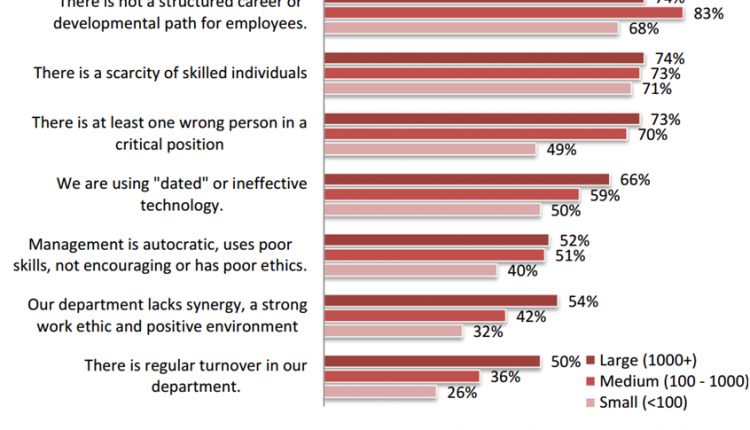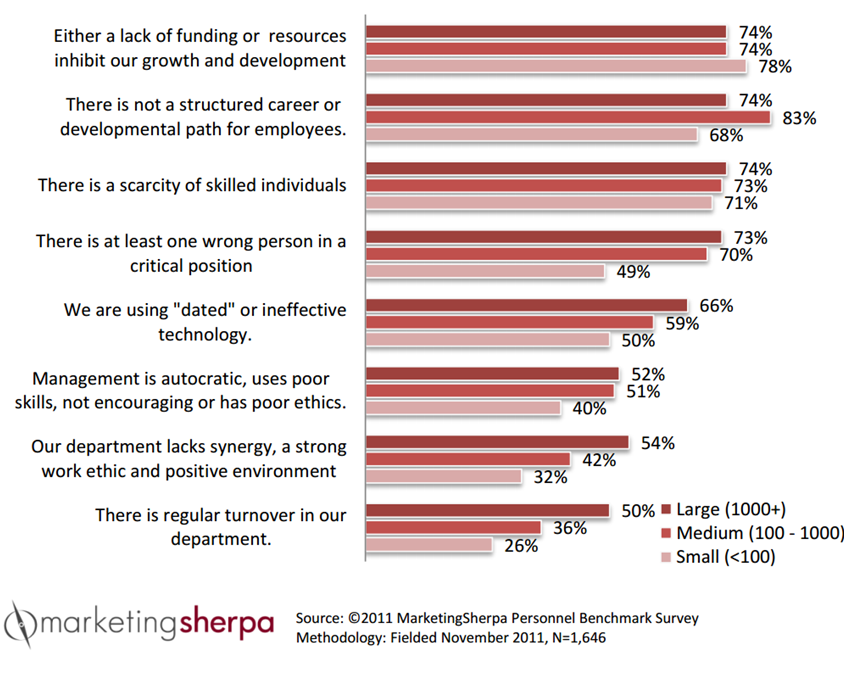According to the MarketingSherpa Executive Guide to Marketing Personnel, people issues dominate marketing department challenges.
Q: What challenges undermine your marketing department’s potential?
Today on the MarketingExperiments blog, let’s focus on the “There is a scarcity of skilled individuals” challenge.
Other departments within a company have increased their productivity and efficiency by leveraging a repeatable methodology and management methods.
For example, manufacturing has Six Sigma. IT has agile software development.
However, marketing tends to focus on individual skilled performers. If your agency or department has a rock star or two, your group will likely perform well. Without them, or when they leave, it can be much tougher to succeed.
A patented marketing methodology
One way to improve the success of your marketing department beyond star performers is to use a repeatable methodology.
Last year, Digital Trust, Inc. (parent company of MECLABS) received a patent from the U.S. Patent and Trademark Office. The patent was originally filed in January 2007. I’ll tell you a little bit more about how you can use this methodology in just a moment, but first our lawyer will explain the patent in more detail …
“On April 10, 2012, Digital Trust, Inc. received a United States Patent (Pat. No. 8,155,995) for an invention developed by co-inventors Flint McGlaughlin and Jalali Hartman,” said Francine Palmeri, Corporate Counsel, MECLABS.
“This patent protects, among other inventions, an innovative method of assessing the effectiveness of a network-based marketing campaign. Specifically, this patented process includes establishing a home website that is linked to several other different parallel websites for presenting an offer for a product. This method then tracks statistics among the several parallel websites for received product orders and determines which website has the highest probability of order placement,” Francine continued.
Understanding the elements that influence conversion
Now that we’ve discussed the exact legal definition, let’s dive in to see how this patented process can help you. What Flint McGlaughlin, Managing Director, MECLABS, created combines the use of analogy and heuristics – a heuristic is an experienced-based technique that helps you identify the elements necessary to solve a usually large problem in a short amount of time.
“The patent is a Test Protocol system that attempts to bring discipline to the behavioral testing process. The Test Protocol system integrates a Design of Experiments with data tracking and validation calculations in the experiment,” Flint said.
 One of the key heuristics in the patent is the Conversion Sequence.
One of the key heuristics in the patent is the Conversion Sequence.
The Conversion Sequence helps you, or anyone on your team from the intern to the CEO, look at any marketing offer and understand what factors you can change to improve the likelihood of conversion of that offer.
The numbers indicate the impact of each element on conversion, and the plus and minus signs indicate whether those elements have a positive or negative impact on the probability of conversion.
Here is a high-level look at each element, and you can learn more about this heuristic in the Landing Page Optimization online course.
Motivation of user
Motivation is the magnitude and nature of the customer’s demand for the product.
For example, I suffer from alopecia. Which is a fancy way to say … I’m bald. So, I have high motivation to buy Rogaine. If I was overweight, I would be motivated to buy a weight loss aid. If I had acne, I would be highly motivated to buy an acne treatment.
Clarity of value proposition
Why should a customer buy from one company instead of a competitor?
As an example, I like to show a MacBook Air laptop next to a Toshiba laptop. The audience always knows who made the MacBook.
As for the Toshiba, they usually guess a random PC maker.
Apple has a clear value proposition. Most other PC makers do not.
Additional incentive to take action
The incentive is an appealing element marketers introduce to stimulate a desired action. For example, free shipping, free samples with purchase, cash back or a buy one, get one free offer.
Friction elements present
Friction is psychological resistance to a given element in the sales process. It could be the length of the process, such as a long form that needs to be completed, or the difficulty of the process.
Anxiety elements present
Anxiety is a psychological concern stimulated by a given element in the conversion process. Asking for a Social Security number before a prospect can purchase would, for example, induce anxiety.
Related Resources:
MarketingExperiments methodology
Optimizing Offer Pages: Steps that increased conversion 148%





Howdy! I just wish to give you a big thumbs up for the excellent info you have here on this post. I will be coming back to your web site for more soon.